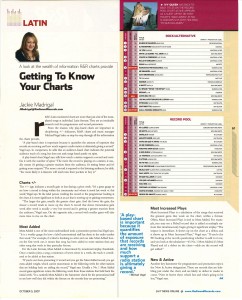(click on picture to open file)
Interview With: Michael D. Vogel
By: Jackie Madrigal
© October 5, 2007. Michael D. Vogel. All Rights Reserved.
Published in:
Radio & Records Magazine – October 5, 2007
Getting To Know Your Charts – A look at the wealth of information R&R charts provide:
R&R’s Latin monitored charts are more than just a list of the most-played songs at individual Latin formats. They are an invaluable research tool for programmers and record promoters.
From the reasons why play-based charts are important to deciphering +/- indicators, R&R charts and music manager Michael D. Vogel takes us step by step through all the information the charts provide.
“A play-based chart is important because it quantifies the amount of exposure that records are receiving and how much support a radio station is ultimately giving a record,” Vogel says. In comparison, he adds that an audience-based chart indicates the potential audience reach of a song, but does not rank songs based purely on spins.
A play-based chart, Vogel says, tells how much a station supports a record and certifies it with the number of spins: “The more a record is playing on a station usually means it’s getting a greater reaction from the audience, testing better or getting more requests.” The more a record is exposed to the listening audience, he adds, “the more likely it is for listeners to reach into their pockets to buy it.”
Charts +/-
The +/- sign indicates a records gain or loss during a given week. “It’s a great gauge to see how a record is doing within the community and where it stood last week vs. this week,” Vogel says. To the label person working the record or the programmer looking at the chart, it is more significant to look at an act that is moving up and gaining momentum.
“The larger the gain, usually the greater the chart gain. And the lower the gain, the slower a record tends to move up the chart. A record that shows tremendous gain week after week is usually a very hot record and is getting a greater reaction from the audience.” Vogel says. On the opposite side, a record with smaller gains will take more time to rise on the chart.
Most Added
Most Added is one of the most under-utilized tools a promotion person has, Vogel says. “It is a weekly gauge for how a label’s promotional staff has done in the radio market that week.” For example, if a label is (trying to) break an artist and can take Most Added honors the first week out; it means that song has been added to more stations than any other song that week in that particular format.
For the Latin formats, monitored airplay thresholds determine Most Added. Once a station plays a song a minimum of seven times in a week, the track is designated as an added at that station.
“If you’re out there promoting ‘x’ record and you get the Most Added record (for that week), you get extra added weight in a programmers decision process, which then carries momentum to the following week for other stations that are holding back on adding the record,” Vogel says. Usually,, a No.1 Most Added record gains significant action the following week from those stations that held back the initial week. “In a nutshell, Most Added is the barometer check for the promotional staff to see ho well they did within the format on the records they are promoting.”
Most Increased Plays
Most Increased Plays is a tabulation of the songs that received the greatest gains that week on the chart, within a format. Often, Most Increased Plays is tied to Most Added. For example, you may see a Pitbull record that is added at multiple stations that simultaneously begin giving it significant airplay. “The impact is immediate. It shows up on the chart as a debut, and it shows up in Most Increased Plays, “Vogel says. “If you’re the Program Director looking at the record, questioning whether to add it or not, and you look at the tabulation – it’s No.1 Most Added, it’s Most Played and it’s a debut on the chart – odds are the record will get added.”
New & Active
Another key barometer for programmers and promotion reps is the New & Active designation. These are records that are bubbling just under the chart, and are likely to debut in weeks to come. “New & Active” show what’s hot and what’s going to be hot,” Vogel says.
© October 5, 2007. Michael D. Vogel. All Rights Reserved. This originally appeared on the Vogelism blog at https://www.vogelism.com, authored by Michael D. Vogel. This article may be shared or reprinted as long as this entire copyright message, including the source location of this article, accompanies it.













 Welcome to Michael D. Vogel’s online portfolio. I am a Los Angeles-based music journalist/content creator, and self-professed music-fanatic/radio-aholic. With more than 20 years of experience in multiple facets of the music industry including; music programming/air talent for terrestrial and internet radio as well as record label artist promotion, I have a finger on the pulse of what's new and under the radar in the emerging music scene. Areas of specific expertise include, but not limited to: rock (heritage, mainstream, heavy metal/hard rock and alternative), pop and adult contemporary, as well as radio, pop culture, sports, exercise and politics. I am applying my passion for music as a freelance writer for the Examiner as National Music Examiner (Examiner.com) in addition to West Coast Editor for FreeGotham (FreeGotham.com). Find me at michael@vogelism.com.
Welcome to Michael D. Vogel’s online portfolio. I am a Los Angeles-based music journalist/content creator, and self-professed music-fanatic/radio-aholic. With more than 20 years of experience in multiple facets of the music industry including; music programming/air talent for terrestrial and internet radio as well as record label artist promotion, I have a finger on the pulse of what's new and under the radar in the emerging music scene. Areas of specific expertise include, but not limited to: rock (heritage, mainstream, heavy metal/hard rock and alternative), pop and adult contemporary, as well as radio, pop culture, sports, exercise and politics. I am applying my passion for music as a freelance writer for the Examiner as National Music Examiner (Examiner.com) in addition to West Coast Editor for FreeGotham (FreeGotham.com). Find me at michael@vogelism.com. 
Hi there! This is my first comment here so I just wanted to give a quick shout out and tell you I really enjoyed reading this.
The most difficult thing is to find a blog with unique and fresh content but your blog is different. Bravo.